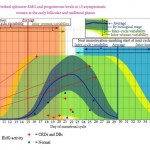Editorial: Do ‘whale noises’ help in the diagnosis of Fowler’s syndrome?
In 1985, Clare Fowler described the presence of abnormal electromyography (EMG) signals in the urethral sphincter of five women with unexplained urinary retention [1]. The presence of complex repetitive discharges (CRD) and decelerating bursts (DB) in women with urinary retention became an important diagnostic finding. Initially, it was described as an EMG finding resembling pseudomyotonia (delayed relaxation of striated muscle when deep tendon reflexes are elicited). Later, an association with polycystic ovary syndrome was hypothesized [2]. This hypothesis could not be proven, however, and the diagnostic criteria that were used at that time for diagnosing polycystic ovaries did not stand the test of time.
The main achievement of urethral sphincter EMG in women with urinary retention was the fact that, from that point onwards, women who were previously described and as being hysterical could now finally be assured that there was a measurable abnormality within their urethral sphincter. This was a major breakthrough in the management of women with urinary retention. Previously, most of these women ended up with permanent catheters or intermittent catheterization, while being stigmatized as psychiatric patients.
The presence of this EMG abnormality also seemed to correlate with the long-term outcome of sacral nerve stimulation [3]. Sacral nerve stimulation is now the standard of care for women with Fowler’s syndrome.
Many authors have questioned the value of these EMG findings. Ramm et al. [4] found the presence of CRD in 30% of healthy women and Tawadros et al. [5] also found this in 53% of healthy female volunteers. These authors showed that CRD and DB are mostly present during the luteal phase of the menstrual cycle. These results suggest at least some hormonal influence on the EMG findings. Fitzgerald et al. [6] showed that CRD correlated weakly with a history of strained voiding and urethral dilation, suggesting a higher prevalence in women with signs of obstructive voiding. Currently, however, the presence of CRD and DB is considered as non-specific.
While sphincter overactivity is generally accepted as the underlying aetiology in women with urinary retention, proving this overactivity remains a challenge. Urethral pressure profiles and urethral volume measurements by ultrasonography have a high interobserver variability and must be used with caution. Most publications originate from one centre and have not been reproduced by others [7]. MRI measurements of the urethral sphincter could possibly be helpful in the future.
While in healthy women CRD can be present, more research will be needed to establish the real value of sphincter EMG in women with pathological urinary retention. The design of good clinical trials will be difficult because of the limited number of patients with this condition. Currently, the diagnosis of Fowler syndrome remains a clinical one, based on a multimodal assessment of the patient.



